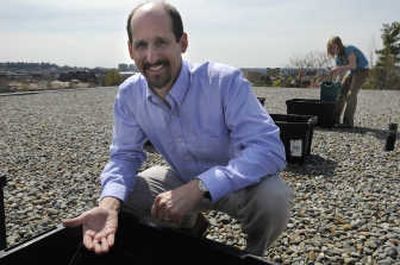Finding a plus side to pollution

For more than a decade, Hugh Lefcort has researched and published scientific papers on the damage done to snails by heavy metals pollution in the Coeur d’Alene River Basin.
But time and time again, something unexpected popped up: At low levels of exposure, the snails seemed to flourish, growing larger and producing more offspring.
“They definitely were hurt by medium and high levels, but the lowest levels always seemed to be a little positive,” said Lefcort, a professor of biology at Gonzaga University. “I was always a little embarrassed by that result because it didn’t fit.”
So Lefcort examined the phenomenon more closely, and found that in regional snail populations, those exposed to low levels of zinc, cadmium and lead grew about 15 percent larger and produced about 15 percent more offspring than those in clean water, he said. The research was published in April in the journal EcoHealth – with a subtitle asking, “Is a Little Bit of Pollution Good?”
The research offers a new way to think about cleanup standards used by the federal government in cases like the Bunker Hill Superfund site, Lefcort said. Current cleanup standards regard pollutants as equally bad at all levels of exposure, whereas research by Lefcort and others suggests there may be some beneficial effects at lower doses.
Lefcort said that doesn’t eliminate the need to clean up pollution but provides food for thought as federal regulators consider cleanup levels for polluted sites.
“You still need to clean it up,” he said. “There’s no doubt about that. But don’t be surprised when you get some negative effects down the road.”
Lefcort’s findings fit into a growing body of research into hormesis – the study of toxic substances that show positive effects in small amounts.
An example is taking zinc – which is toxic at high doses – for a cold, he said.
Research into hormetic effects has grown rapidly in recent years and has set off a debate over the proper response from regulators. In a pair of competing essays in the journal Environmental Health Perspectives in 2006, scientists debated whether regulators should consider hormetic effects when setting standards for environmental cleanups.
Proponents say that hormetic effects have been confirmed in a wide range of pollutants, and researchers Ralph Cook and Edward Calabrese describe it as a “ubiquitous natural phenomenon.”
“It is important to recognize that striving to reduce some exposures ever lower, simply because it is possible, may not be only unnecessary for the public health, but it may be counterproductive,” the authors wrote.
Two National Institutes of Health scientists took strong exception to that article, arguing that evidence is limited and the ability to interpret the complex effects of various toxic agents in the environment is difficult. In one example, they said that while low levels of cadmium had been associated with lower levels of testicular cancer in rats, they’d also been associated with increases in prostate tumors.
Allowing higher amounts of toxic substances to remain in the environment is “totally unjustified public health policy that would impose greater involuntary risks on sizable segments of the population,” they wrote.
Lefcort has studied snails in the Coeur d’Alene River Basin since 1996, and he’s published several papers outlining the damage done to snails by heavy metals. For his most recently research, Lefcort studied snail populations in the Lateral Lakes region around the western end of the South Fork of the Coeur d’Alene River, and compared them with snails from waters around the Turnbull area south of Spokane, which had not been exposed to heavy metals.
In this study, Lefcort examined levels of lead, cadmium and zinc in snails at low levels of exposure compared to those with no exposure.
At higher levels, the negative effects are well-known, he said – Exhibit A being the former snails of the Silver Valley. “In the Silver Valley all the snails are dead,” he said. “They’ve been dead for 100 years. I’ve never found a snail there.”
At medium levels, heavy metals affect the growth, reproduction and development of the snails.
But at the lowest levels, the metals appeared to kill off parasites that hampered the snail’s growth.
He said there may be an evolutionary basis for the effects at low levels of exposure – snail species in the region may have adapted to the metals or those that benefit from the metals may have thrived in competition with others. Snails produce a generation each year, well over 100 since mining’s heyday.
“That’s enough time for evolution,” Lefcort said.
The results don’t suggest any direct path for regulators in the Silver Valley, and Lefcort said he’s not arguing for one. For one thing, the levels that have a positive effect in snails could still be harmful to human health if they travel up the food chain to fish and people, Lefcort said. And the metals are so embedded through the entire river basin that it’s impossible to completely remove them – or even most of them.
But the results might suggest a rethinking of the federal approach that toxic substances are equally bad at all doses, he said. And there’s an irony in the fact that if such a cleanup were carried out, Lefcort said: It might hurt not just the snails but the fish that feed on them – and the tourism industry that relies on fishing throughout the region.
“It just kind of says life’s a little more complicated,” he said.